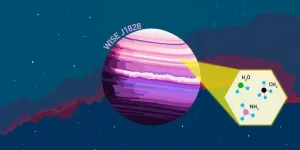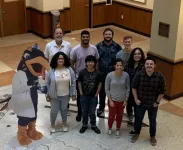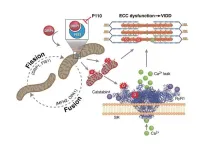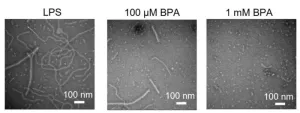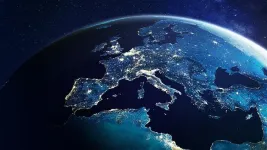They reveal the origin of wine, the age of bones and fossils, and they serve as diagnostic tools in medicine. Isotopes and isotopologues – molecules that differ only in the composition of their isotopes – also play an increasingly important role in astronomy. For example, the ratio of carbon-12 (12C) to carbon-13 (13C) isotopes in the atmosphere of an exoplanet allows scientists to infer the distance at which the exoplanet orbits its central star.
Until now, 12C and 13C bound in carbon monoxide were the only isotopologues that could be measured in the atmosphere of an exoplanet. Now a team of researchers has succeeded in detecting ammonia isotopologues in the atmosphere of a cold brown dwarf. As the team has just reported in the journal Nature, ammonia could be measured in the form of 14NH3 and 15NH3. Astrophysicists Polychronis Patapis and Adrian Glauser, who are members of the Department of Physics as well as of the National Centre of Competence in Research (NCCR) PlanetS, were involved in the study – Patapis as one of the first authors.
In search of ammonia
Brown dwarfs are somewhere in between stars and planets: they resemble giant gas planets in many ways, which is why they can be used as a model system to study gas giants. In their work, Patapis and colleagues observed a brown dwarf, called WISE J1828, that's 32.5 light years away from Earth; in the night sky, it is located in the constellation Lyra, the lyre. WISE J1828 cannot be seen with the naked eye: with an effective temperature (that is, the temperature of a blackbody that would emit the same amount of energy as the observed object) of only 100°C, it is far too cold for hydrogen fusion to take place and send light all the way to Earth. To spot this ultracold dwarf star of the Y spectral class, the mirrors of the James Webb Space Telescope (JWST) were turned in the direction of the lyre last summer.
The Mid-InfraRed Instrument (MIRI), an infrared detector installed on board the JWST, made it possible to reveal the ammonia isotopologues on WISE J1828. In the wavelength range between 4.9 and 27.9 μm, the Medium Resolution Spectrometer (MRS) of MIRI recorded a spectrum of the brown dwarf where, in addition to ammonia, the researchers observed water and methane molecules, each with characteristic absorption bands. In particular, ammonia causes an attenuation of the signal arriving at the detector in the wavelength range between 9 and 13 μm.
The isotopologues of ammonia can also be resolved spectroscopically: if ammonia molecules don't consist of the most common nitrogen isotope 14N, which is bound to three hydrogen atoms, but of 15N plus three hydrogen atoms, the additional neutron in the nitrogen nucleus ensures that there is a kink in the spectrum that can be explained by the presence of 15NH3.
A new diagnostic for exoplanets
The ratio of the two isotopologues of ammonia measured in the atmosphere of WISE J1828 is especially exciting: as Patapis and colleagues explain, the 14NH3-to-15NH3 ratio is a tracer, that is, an indicator that can be used in the future to study star and planet formation. It's a new tool that will help to test different, known formation mechanisms for gas giants.
Gas giants such as Jupiter or Saturn are not special to our Solar System. These bodies play an important role in the study of exoplanets: they appear early during the formation of stars and are thus a crucial factor determining whether and how smaller, lighter planets develop. Until now, there has been no definitive answer to the question of how massive gas giants form. Experts have developed different theories, but it's unclear whether these planets form by nuclear accretion – like most other planets – or as a result of gravitational collapse in the protoplanetary disk around the progenitor star.
The isotopologue ratio recorded by Patapis and coworkers can provide new clues. On Earth, there are 272 14N atoms for every 15N atom. The paper reports that the 14NH3-to-15NH3 ratio measured in the atmosphere of WISE J1828 is 670, which means that the brown dwarf has accumulated less nitrogen-15 in the course of its formation compared to that of Earth and other planets such as Jupiter. In fact, the abundance of 15N is scarcer on WISE J1828 than it is on all celestial bodies in our Solar System.
Different scenarios for planet formation
The processes of so-called isotope fractionation, that is, the change in isotope abundance, aren't fully understood, but comet impacts are thought to contribute to an enrichment of nitrogen-15 because comets have a significantly higher 15N content. Comet impacts are also believed to be a fundamental planetary building block in the Solar System: comets contributed to the formation of Earth's atmosphere, even though it isn't entirely clear to what extent.
A low 15NH3 content in the spectrum of WISE J1828 suggests that the brown dwarf didn't follow the usual way of planet formation – namely, nuclear accretion – but formed star-like instead, a scenario that points to gravitational collapse. This type of gravitational instability is thus likely to play an important role in the formation of gas giants, especially those that move around their star on large orbits. Indeed, this is another significant point discussed in the paper: the 14NH3-to-15NH3 ratio appears to vary greatly depending on the distance between a gas giant and its star, as shown by simulations of a forming planet between the ammonia and molecular nitrogen ice lines. In astronomy, ice lines indicate the minimum distances from the central star at which the temperature is low enough for a particular volatile chemical compound to change to a solid form. According to Patapis and colleagues, the observation of an increased 14NH3-to-15NH3 ratio could indicate planetary accretion of ices between the ammonia and nitrogen ice lines.
Astronomers have just gained an additional tool to study directly observable exoplanets. The ammonia trail only became tangible thanks to the JWST, confirming once again the enormous value and unparalleled performance of this space telescope.
END
